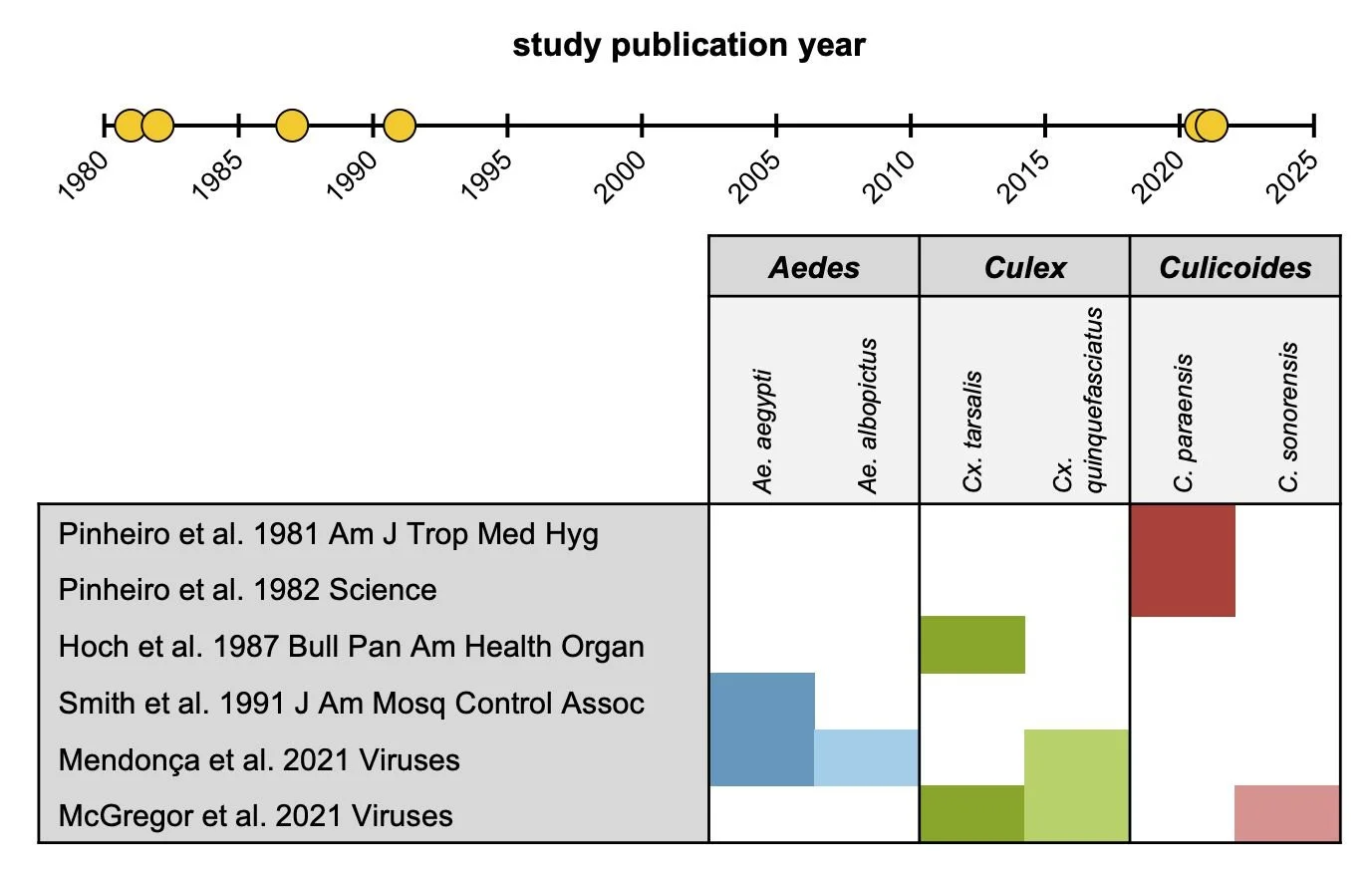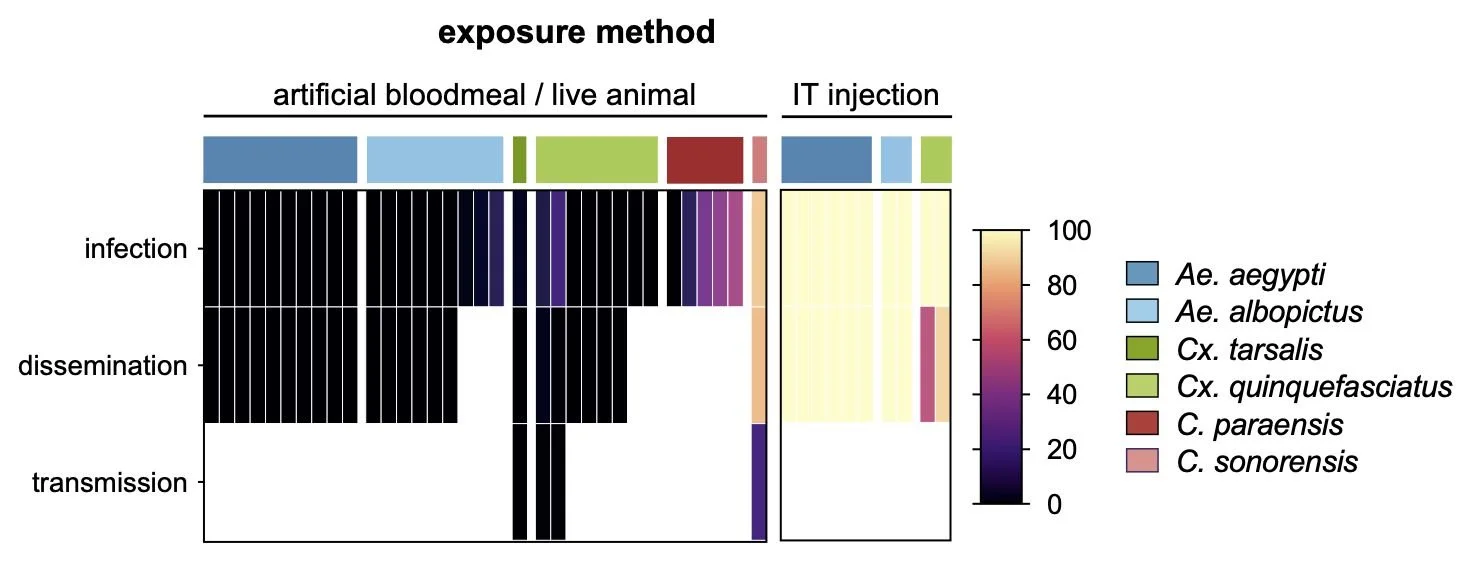Data release: Oropouche virus vector competence
tl;dr:
Oropouche virus is an orthobunyavirus (Peribunyaviridae: Orthobunyavirus), which causes symptoms that are similar to dengue and several other arthropod-borne viruses. Oropouche virus and its relatives are unusual in that they are mainly transmitted by midges (Culicoides spp.), rather than mosquitoes. Over the last year or so, there have been over 8,000 cases of Oropouche virus in the Americas, including a small number of cases of potential fetal abnormalities or deaths. The reasons for this unusual epidemic are unclear, although climate change and El Niño may both be involved.
Several arbovirology labs are shifting effort towards characterizing this relatively understudied virus. To help them out, we’re releasing a small compendium of raw data from vector competence experiments with OROV prior to the 2023-24 epidemic in the Americas. The dataset is available on Figshare, and the data have been standardized following a template we developed back in 2022. As part of this release, you can also access a new, better version of the data template on Github.
About the data release.
How should I use these data?
However you like! But, if you use the dataset, please cite the dataset as:
Gallichotte, Emily; Ebel, Gregory; Carlson, Colin (2024). Oropouche vector competence data. figshare. Dataset. https://doi.org/10.6084/m9.figshare.27157029.v1
Within the next few weeks, a preprint of our systematic review will be posted to accompany the dataset. Please cite both once the preprint is posted, and check back here for updates.
Why did we do this?
Over the last three years, we’ve been building a database of raw data and metadata from vector competence experiments called COMET. We’re getting close to releasing that dataset, and have gotten good at standardizing data from across studies - thanks, in no small part, to our data standard and template. It was easy for us to pull this dataset together: only a handful of researchers did any work with Oropouche virus over the last few decades, so the amount of data to synthesize was very small, compared to what we’re sifting through for well-studied pathogens like dengue or Zika virus.
These data provide important insights into the biology of the pathogen, and help scientists understand which experiments are useful to do now (or have already been done!). We’re hoping that these data can also be used by public health authorities: for example, they reinforce the idea that if mosquitoes can transmit the virus, they currently play a very small role in transmission compared to midges. Plus, now that we have these data, we can add them directly into the COMET database.
Where did the data come from?
We’ve conducted a PRISMA-compliant systematic review of literature on Oropouche virus from PubMed. There were only 168 publications, out of which only six studies conducted vector competence experiments. We extracted raw data from these six studies, and – as necessary – emailed authors to confirm important details about study design. (Thanks to Silvana Mendonça and colleagues for the assistance!) We also checked a previous systematic review we conducted, but none of those 200+ studies looked at Oropouche virus (in part because we focused our search on viruses transmitted by mosquitoes).
Some more technical details: we only looked at peer-reviewed literature, and so have necessarily excluded some older technical reports. We also excluded studies looking at mechanical transmission experiments and viral prevalence in wild-caught arthropods, vertebrates, or humans.
Our methods will be described in more detail in the forthcoming preprint.
Will you update the dataset?
We know that a number of labs are currently planning or already conducting new experiments with Oropouche virus. We’ll continue to update our dataset every three months to incorporate any raw data that becomes available, for a maximum of one year. After that point, we’re hoping that the COMET database will be live, and will replace this ad hoc effort.
If you have Oropouche vector competence data to share, please reach out directly, or consider sharing your raw data in the supplement of your publication, using our updated template. If you do, we’ll include your data in future updates and/or in the COMET database.
What the data tell us.
There are very few studies testing the ability of midges or mosquitoes to transmit Oropouche virus. We found six studies, published between 1981 and 2021. Midges are consistently more capable of becoming infected and transmitting the virus. Mosquitoes can be infected by intrathoracic injection, suggesting that the midgut infection (and possibly escape) barrier is a primary point of restriction.
Figure 1. Timeline of publications and which vector species they tested.
Figure 2. Infection, dissemination and transmission rates of mosquito and midge species infected via multiple methods (does not include transmission results to naïve animals).
Image credit for socials thumbnail: modified from GBIF.


